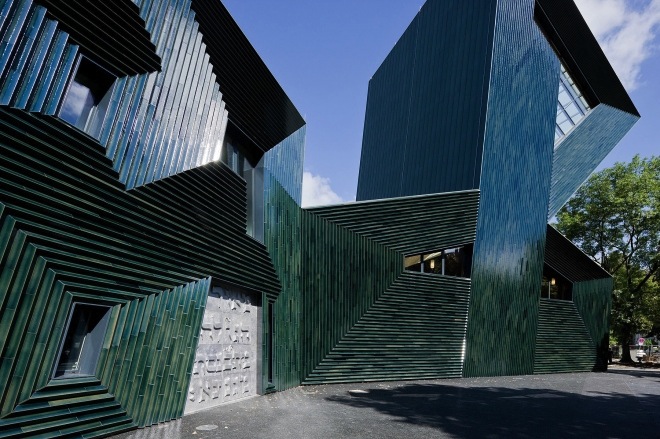Like the other buildings featured this week, ceramics is used as a dominant element, in fact, in this case it is the dominant element. Glazed, green ceramic tiles encase the synagogue in what almost seems to be armor, giving the building a rooted permanence—a safe haven—yet the color, forest green, is welcoming and fecund.
Manuel Herz Architects of Basel and Cologne have taken on an historically delicate task in designing this Centre for the Jewish Community in Mainz, Germany. This town is freighted with a long history of virulent anti-semitism going back 900 years, when it was still known as Magenza. Jews were constantly being driven out and then stubbornly returning. Its Jewish community was all but wiped out during the Holocaust of WWII. But true to form, they came back. By 1980, fifteen families had made Mainz their home and then with an influx of Eastern European immigrants, the community grew six-fold and a new place of assembly and worship was needed.
The shape of the building is abstractly based on the Hebrew word for blessing and is curved around a public courtyard. The center houses a synagogue, office spaces, schoolrooms, and a multipurpose space. The interior walls of the synagogue are covered in densely packed Hebrew letters, in some areas the text is arranged into poetry written by 10th century rabbis.
Manuel Herz explains the importance of the building’s exterior:
The glazed ceramic façade points to a different layer of writing and scripture. Similar to a process of inscription or carving a pattern, a rippled and three-dimensional surface is formed with ceramic tiles. This pattern is arranged in a concentric way around the windows thus creating a perspectival play of dimensionality. Multiple perspectives with the windows being their vanishing points emerge within the building’s facade. This spatial quality is enhanced by the transparent green glazing of the ceramic tiles, which reflects the shifting light conditions of its surroundings and displays a wide array of hues and shades.
Jewish communities in Germany are often marked by the desire not to raise much attention with their activities. They play only a minor role in the social and cultural live of a city. This synagogue, in a city of one of the most important Jewish communities, tries to help develop a different consciousness. The new synagogue is a building that with confidence marks a new active place on the map of the city. It wants to attract the inhabitants of the city, Jews as well as non-Jews, for them to participate in its religious, social and cultural activities. It is a building that will raise attention, maybe questions, doubts, interests or maybe even anger, but also hope. First and foremost it is a building that will help make the Jews of Mainz into a visible and active part of society and link them with their rich history. In Germany, a country where synagogues always also have a political relevance, this building shows the power of Diaspora.
The building was nominated for the 2011 Mies van Rohe Award for European Architecture and was winner of the German Facade Award in the same year. Niels Diedrichs Keramikwerkstatte of Cologne was the consultant for the ceramic facade planning.
Garth Clark is the Chief Editor of CFile.
Image above: Jewish Community Center Mainz designed by Manuel Herz Architects located in Mainz, Germany. Photos © Iwan Baan.



Jewish Community Center Mainz designed by Manuel Herz Architects located in Mainz, Germany. All images courtesy of Manuel Herz Architects. Photos © Iwan Baan.





Add your valued opinion to this post.